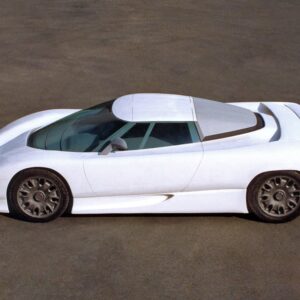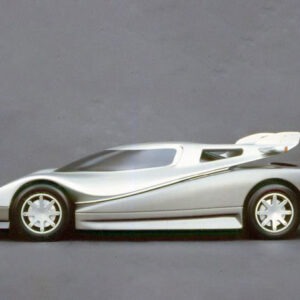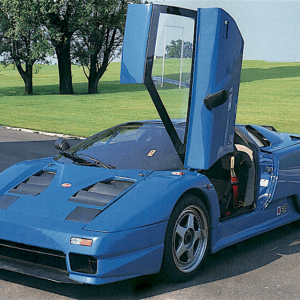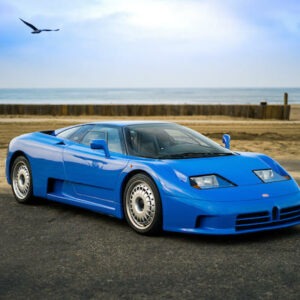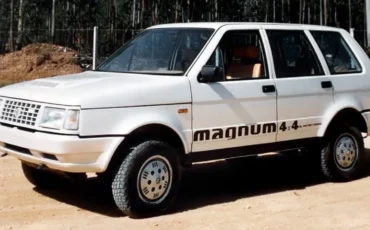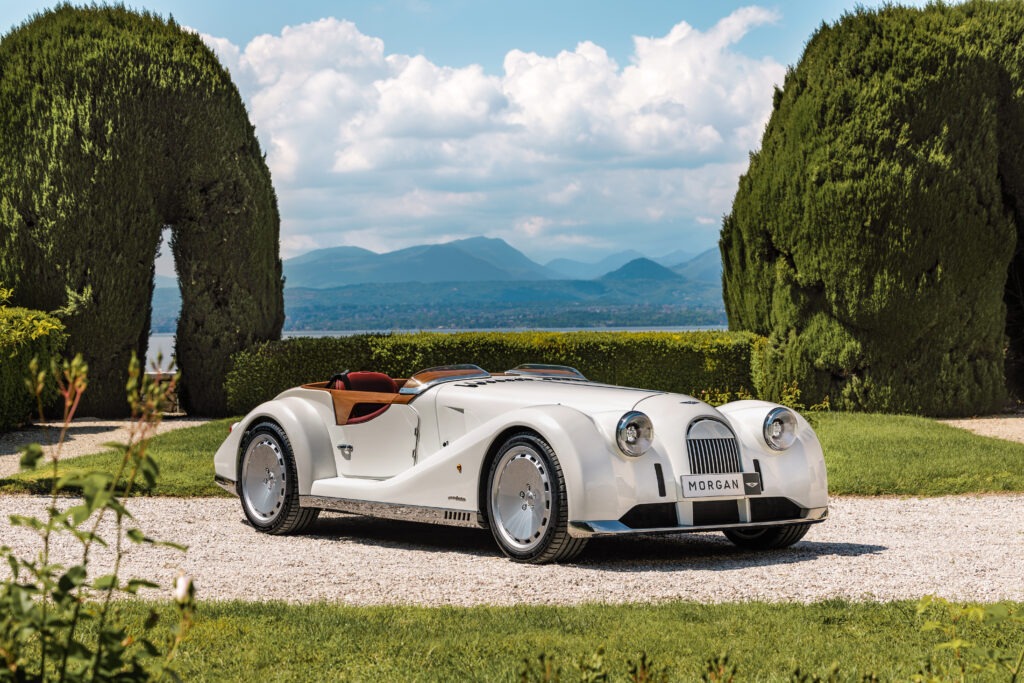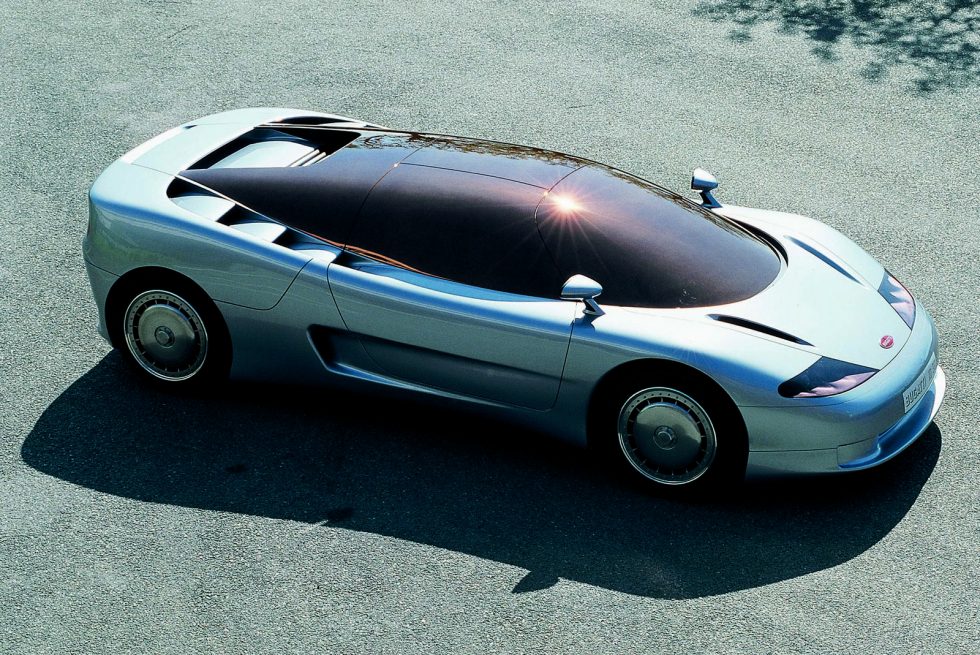
Introducing the Bugatti ID90
The Bugatti ID90 stands as a testament to the visionary work of Giorgetto Giugiaro. Unveiled at the 63rd International Car Show in Turin, this concept car was more than just a futuristic representation; it was a bold exploration of form and function, drawing inspiration from the technical drawings of Bugatti mechanics published in the late 1980s.
Giugiaro, renowned for his innovative approach to automotive design, took the opportunity to freely interpret a classical yet advanced design theme. The result was a mid-engined two-seater coupé that adhered to the compact dimensions specified by Bugatti Automobili Spa – 4,100 mm long and 1,840 mm wide.
What set the Bugatti ID90 apart was not just its adherence to Bugatti’s traditions but also its departure from the norm. The typically metallic grey palette was eschewed in favor of a light, metallic blue, showcasing Giugiaro’s penchant for breaking free from conventional norms.
The Design Competition
This conceptual masterpiece was not driven solely by the re-birth of the Bugatti brand; instead, it was a manifestation of creative freedom. The design was not bound by the imminent release of the EB110; it was an independent exploration of possibilities.
Interestingly, other renowned designers, including Gandini, Bertone, and Paolo Martin, also presented their visions for Bugatti’s future. The competition among these esteemed designers was fierce, with each offering their unique take on the iconic brand. Ultimately, the version proposed by Gandini was selected, leading to the creation of a prototype. However, the final design underwent significant refinement and modification under the expertise of Giampaolo Benedini, adding his distinctive touch to the iteration.
It’s noteworthy that while Gandini’s proposal was initially intended for Bugatti, it found its way to the Maserati Chubasco, albeit with slight modifications. Similarly, the Bertone design was repurposed for the Lotus Emotion. Meanwhile, the Bugatti ID90, later built independently by Italdesign, stood as a separate venture, showcasing the diverse interpretations of Bugatti’s future by different design houses. This interplay of ideas and adaptations underscores the dynamic nature of automotive design and the collaborative spirit within the industry, ultimately contributing to the rich tapestry of automotive history.
The ID90 in Detail
The Bugatti ID90, a compact two-seater marvel, effortlessly aligns with contemporary design trends, embracing the smooth and sinewy lines characteristic of modern sports cars. Its profile is distinguished by an elongated glazed dome that gracefully extends beyond the axis of the wheel centers, setting it apart from the conventional design cues seen in both competition cars and traditional saloons.
Unlike the semi-circular appearance of glazed domes in rival vehicles or the trapezium shape found in traditional saloons, the Bugatti ID90 presents a unique cross-section characterized by a single rounded curve. This distinctive feature represents a harmonious compromise between the aerodynamic styling of competition cars and the elegance of traditional saloons.
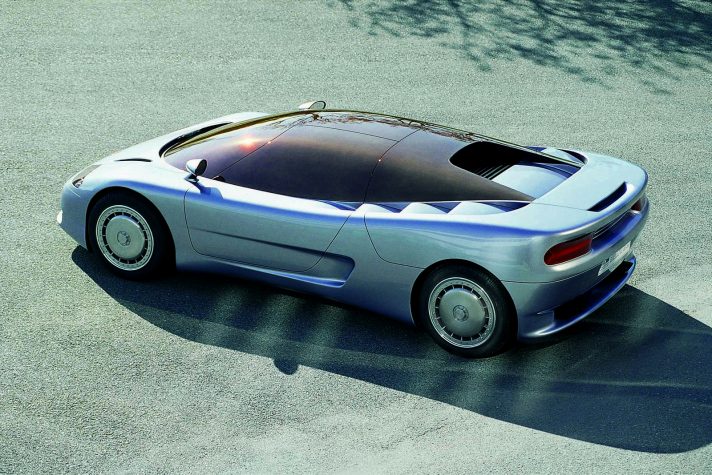
The wedge-shaped beltline further animates the car’s profile, showcasing a sinusoidal movement that gracefully ascends from the front to the rear, subtly dipping in the center. The car’s body, supporting the glazed dome with mirrored glass reminiscent of architectural design, features a protective shoulder. This shoulder, starting from the door cut, not only houses the air intakes but also gracefully encircles the upper tail frame.
The integration of a trapezium-section rear spoiler into the upper tail frame is a masterstroke, ensuring a seamless appearance when viewed from the side. An aerial perspective reveals concentric ellipses, a design element close to Giugiaro’s heart. The drop-like shape etched along the perimeter of the glass roof panel tapers towards the rear, allowing for the incorporation of three fins on the air intakes, reminiscent of the Lotus Etna.
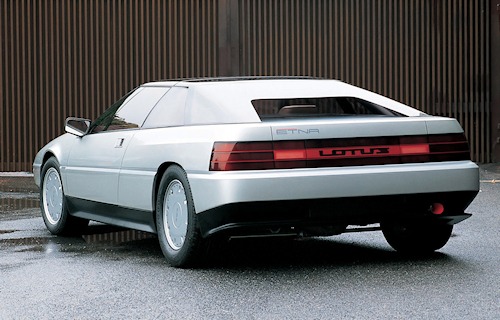
An intricate engineering consideration is evident in the design, as the end part of the rear window is purposefully hollowed to facilitate the efficient extraction of hot air from the engine compartment. A top-down view accentuates the impressive width of both the front and rear mudguards. The rear spoiler, emerging seamlessly from the tail frame, culminates in a relief meticulously shaped for optimal aerodynamic efficiency.
Giugiaro’s meticulous approach to detail is apparent in the thoughtful design of the air intakes. Balancing the need for ventilation in an engine compartment housing four turbos and two intercoolers, these intakes seamlessly blend into the overall shape, avoiding any harsh disruptions to the car’s body. The upper part of the rear mudguard, in particular, showcases the result of extensive work, featuring a long air vent with perfect airflow through three small-section longitudinal fins, delicately separated by a fine grille.
In essence, the Bugatti ID90 epitomizes Giugiaro’s pursuit of design excellence, where every curve and contour serves both aesthetic and functional purposes, creating a captivating synthesis of innovation and aerodynamic efficiency.
The Bugatti ID90 presents a visually striking and uniquely designed front end, marked by an aggressive yet rounded appearance. The dominating feature is a large spoiler at the base of the bumper, exuding a fierce and closed-off aesthetic. Positioned above this is a sizable air vent designed to cool the water-filled radiator, aligned almost horizontally in a nod to the configuration seen in competition cars. Flanking the central vent are two additional openings dedicated to cooling the brakes, contributing to the car’s high-performance capabilities.
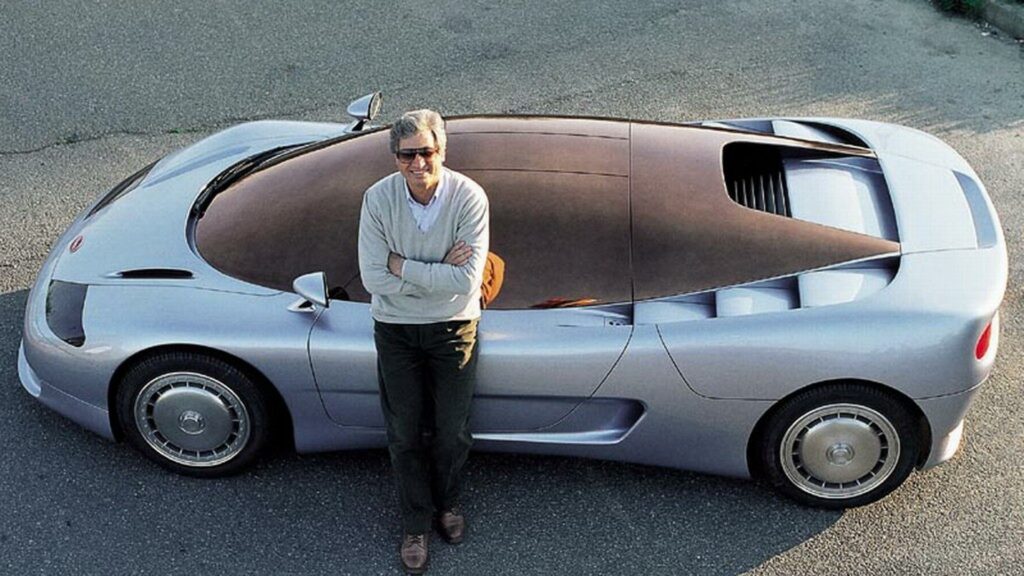
To achieve an efficient extraction of hot air from the radiator, Giugiaro implemented two elliptically shaped longitudinal air outlets sculpted into the bonnet. The interaction between these outlets and the recess between the bonnet and the base of the windscreen creates a distinctive graphic effect. Additionally, the slim-line headlights, housed within the closed bonnet that tapers towards the nose, seamlessly integrate into the ellipsoidal shape of the front. The headlights, covered in plexiglas, enclose three small-section parabolas, with two serving as lights and the side one designated for indicators.
In a design nod reminiscent of the Italdesign Aspid and Aztec concept cars, Giugiaro introduced a unique door configuration. The doors are divided into two elements: the lower part opens traditionally, while the side window, forming the roof, operates as a gull-wing type. When the door is opened, the gull-wing automatically rises, offering a captivating and futuristic entrance. The control inside allows for the selective opening of only the gull-wing, adding a touch of practicality to the avant-garde design.
A thoughtful shallow recess in the lower part of the flank enhances the airflow into the vent situated in the rear mudguard. This not only aids in brake disc ventilation but also contributes to cleaning the engine compartment, showcasing Giugiaro’s attention to both design and functionality.
Moving towards the rear, the Bugatti ID90 exhibits a captivating engine hood that hinges onto the structure between the passenger and engine compartments. This hood incorporates the rear window, fins on the air vents, and part of the rear mudguards, providing convenient access to the mechanical components. The rear is further distinguished by light clusters housed in a recess that splits the tail frame, featuring elongated lights aligned on a slim methacrylate fascia. Below this, a large air outlet functions as a vent for the engine compartment, while two exhaust pipes protrude from the rear bumper. The rear spoiler, ending in a slim design, optimally extracts airflow from the underbody, contributing to the car’s aerodynamic prowess.
A final touch of elegance is found in the design of the light alloy wheel rims, paying homage to the classic Bugatti shape seen in the legendary 1926 Royale. This subtle reference seamlessly connects the contemporary design of the Bugatti ID90 with the timeless heritage of the Bugatti brand.
A final touch of elegance is found in the design of the light alloy wheel rims, paying homage to the classic Bugatti shape seen in the legendary 1926 Royale. This subtle reference seamlessly connects the contemporary design of the Bugatti ID90 with the timeless heritage of the Bugatti brand.
Conclusion
The Bugatti ID90 is a groundbreaking fusion of avant-garde design and practical innovation. Giorgetto Giugiaro’s visionary touch is evident in every detail, from the aggressively rounded front end to the unique gull-wing door configuration. The graphic effects, such as elliptical air outlets and strategically placed vents, add a captivating visual dimension.
The ID90 seamlessly marries futuristic design with everyday functionality, featuring a thoughtful gull-wing door mechanism and practical airflow enhancements. The rear design, including the unique engine hood and elongated light clusters, contributes to both aesthetics and aerodynamics.
In the years following the Bugatti ID90 project, Giorgetto Giugiaro continued to shape Bugatti’s future with iconic models like the EB112, EB118, EB218, and the 18/3 Chiron Concept car. These designs exemplify Giugiaro’s enduring influence on Bugatti’s aesthetic evolution, showcasing his commitment to innovation and elegance. Giugiaro’s legacy extends far beyond a single project, leaving an indelible mark on Bugatti’s design trajectory.

